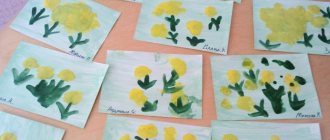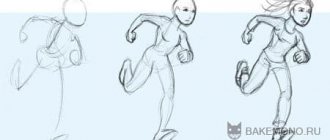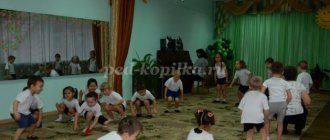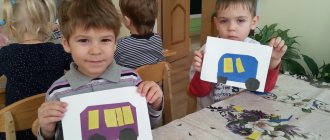The middle group of kindergarten is intended for children of four years of age. During this period, children develop the ability to establish simple connections between surrounding objects. Children are interested in the actions of adults, imitate them in everything, and try to overcome small difficulties on their own. Speech is significantly enriched through communication with adults and peers. The middle group gives children the skills of correct and organized behavior in the garden, on the street, at home. Forms the simplest ideas about what is bad or good. Creativity and ear for music will also improve.
Features of the middle group
In the activities of four-year-old children, an important place is occupied by teaching correct behavior at home and in public places. At the same time, they develop organization and responsibility. Teachers explain to children what to do in certain situations and what not to do. During classes and in free activities, the teacher works to develop the creative abilities of pupils in the middle group of the kindergarten.
Physical development
At this age, the child is physically active. He is able to run, while coordinating and coordinating the work of his legs and arms, jump on two legs, play with a ball and throw it a short distance with his right and left hands, climb the Swedish stairs, climb over various objects, line up in pairs, line up in a circle or line. During this period, some children are already successfully mastering a two-wheeled bicycle.
A number of children show higher data, they develop somewhat faster than their peers, master skills better and faster and absorb information. This does not mean that children who meet the requirements of the middle group program are lagging behind in development and learning. On the contrary, it is the more developed children who stand out from the average level. This is normal and natural, all children are different, and this is not a reason for parents to panic and compare their son or daughter with more developed peers. If the baby meets the level of knowledge of his age, then everything is normal. Small deviations with a minus sign may also occur. Only a strong discrepancy between the child’s age and the level of his physical and mental development should cause alarm.
Middle group of kindergarten: image of a pupil
At this age the child is fully formed. Each has its own character, certain preferences and tastes. Four-year-old children are very active and want to make many friends. Often their activity confuses not only educators, but also parents. Children of four years old practically conquer one height after another. Today it was the back of the sofa, tomorrow it was the window sill, then a heated towel rail in the bathroom, a computer desk. Children want to explore everything. Often such actions are destructive. It is at such moments that many parents begin to send their children to kindergarten groups, where the children’s activities are filled with communication with peers and a variety of activities in which they can release their energy.
“Childhood” program age characteristics of children from 4 to 5 years old
Program "CHILDHOOD"
Age characteristics of children from 4 to 5 years old
The physical capabilities of children have increased: their movements have become much more confident and varied. Preschoolers have an urgent need to move. If active motor activity is limited, they quickly become overexcited, become disobedient, and capricious.
Children actively demonstrate a desire to communicate with peers. Their verbal contacts become more effective and efficient. Preschoolers 4-5 years old willingly cooperate with adults in practical matters, but at the same time they are increasingly striving for cognitive, intellectual communication. The age of “why” is manifested in numerous questions from children to the teacher: “Why?”, “Why?”, “For what?” The child's developing thinking, the ability to establish the simplest connections and relationships between objects awaken a wide interest in the world around him.
The child is able to analyze objects simultaneously according to 2-3 characteristics: color and shape, color, shape and material, etc.
Children aged 4-5 years clearly show interest in the game. The game becomes more complex in content, number of roles and role-playing dialogues. A notable feature of children is their imagination; they often confuse fiction and reality. Children of this age are experiencing an awakening interest in the rules of behavior.
Children are actively developing and maturing their emotional sphere: feelings become deeper and more stable; the previous joyful feeling from communicating with others gradually develops into a more complex feeling of sympathy and affection. In the fifth year of life, awareness of one’s gender begins. Children note the external differences between boys and girls.
Children's vocabulary increases to 2000 words or more. In conversation, the child begins to use complex phrases and sentences.
Planned intermediate results of children's mastery of the basic general education program of preschool education.
Middle group (5 years)
By the age of five, with successful completion of the Program, the following level of development of the child’s integrative qualities is achieved:
Physically developed, mastered basic cultural and hygienic skills.
Anthropometric parameters (height, weight) are normal. Physical capabilities have increased significantly: movements have become much more confident and varied. Experiences an urgent need to move and is highly excitable. If active motor activity is limited, he becomes overexcited, disobedient, and capricious. Emotionally charged activities become not only a means of physical development, but also a way of psychological relief for children of middle preschool age. Performs age-appropriate hygienic procedures and follows basic rules of a healthy lifestyle. Talks about the sequence and necessity of performing cultural and hygienic skills - dressing for a walk, eating and using cutlery, using personal hygiene items. He is independent in self-care, sets goals himself, sees the need to perform certain actions.
Curious, active.
He is highly active and inquisitive. Asks a lot of searching questions: “Why?”, “Why?”, “For what?”. Strives to establish connections and dependencies in nature and the social world. Masters the basic methods of cognition, has some experience in activities and a stock of ideas about the environment, and with the help of the teacher is actively involved in experimentation activities. In the process of joint research activities, actively learns and names the properties and qualities of objects, features of natural objects, and research activities. Unites items and objects into specific categories indicating characteristic features.
Emotionally responsive
. Responds to the emotions of loved ones and friends. To attract and maintain the attention of a peer, he uses means of intonational speech expressiveness - voice strength, intonation, rhythm and tempo of speech. He reads poetry expressively, retells short stories, conveying his attitude towards the characters. Uses words of participation, emotional sympathy, and compassion in speech to maintain cooperation and establish relationships with peers and adults. Using figurative language, he conveys the emotional states of people and animals. Experiences joy from communicating with animals and plants, both familiar and new to him. Empathizes with fairy tale characters. Reacts emotionally to works of art and the natural world.
Mastered the means of communication and ways of interacting with adults and peers.
Actively demonstrates a desire to communicate with peers. Needs meaningful contacts with peers about toys, joint games, and common affairs. Speech contacts become longer and more active, and the first friendly connections between children are established. At the suggestion of the teacher, he can agree with a peer about playing together, select the necessary toys, and create a play environment. Strives for self-expression in activities, recognition and respect of peers. Willingly cooperates with adults not only in practical matters (joint games, work assignments, caring for animals, plants), but also actively strives for cognitive, intellectual communication with adults - asks many questions of a searching nature. Begins to show respect to elders, calling them by name and patronymic. In a familiar environment, he independently follows the familiar rules of communication with adults, says hello and goodbye, says “thank you” and “please.”
Able to manage one’s behavior and plan one’s actions based on primary value concepts, observing basic generally accepted norms and rules of behavior.
Knows different ways of activity, shows independence, strives for self-expression. Behavior is determined by the demands of adults and primary value ideas about “what is good and what is bad” (for example, you can’t fight, it’s bad to tell lies, you need to share, respect adults, etc.). With the help of an adult, he can outline actions aimed at achieving a specific goal. When reminded by an adult, he tries to adhere to the basic rules of behavior at home and on the street.
Able to solve intellectual and personal tasks (problems) appropriate for age.
Can apply acquired knowledge and methods of activity to solve simple problems set by adults. Friendly in communicating with peers in joint activities. Shows interest in various types of activities and actively participates in them. Masters the skills of experimentation and, with the assistance of an adult, actively uses them to solve intellectual and everyday problems.
Having primary ideas about oneself, family, society, state, world and nature.
Self-image.
Knows his first name (full and short), last name, age, gender. He is aware of some of his skills (“I can draw”), knowledge (“I know what this fairy tale is about”), and what he has learned (“to build a house”). Strives to learn from an adult some information about his body (what arms, legs, eyes, eyelashes, etc. are needed for).
Ideas about family
. Knows the composition of his family, talks about the activities of his family members, family events, holidays, favorite toys, pets.
Ideas about society (the nearest society),
its cultural values. Talks with the teacher about the professions of kindergarten workers: assistant teacher, cook, nurse, teacher, laundress.
Ideas about the state.
Knows the name of the country and city in which he lives, orients himself well in his immediate surroundings.
Having mastered the universal prerequisites for educational activities.
Able to work according to a model. Knows how to listen to an adult and carry out his tasks, answer when asked.
Having mastered the necessary skills and abilities.
The child has developed the skills and abilities necessary to carry out various types of children's activities.
Get text
Math classes
Various activities are organized for all kindergarten students. If we talk about mathematics, it can be noted that in the younger group, educators give children basic knowledge in this area, while the middle group assumes the complication of tasks in the formation of elementary mathematical concepts. Mathematics classes include learning to distinguish the constituent parts of a certain group of objects and the formation of concepts of similarities and differences between them. The teacher develops knowledge that a group of objects is larger than the individual thing that is part of it. Already at this age, children are taught to count to ten.
Activities to help your baby
To help your child develop, you can include various games and exercises in his activities that will contribute to the formation of certain skills and abilities. Be sure to introduce outdoor games, combining them with educational ones. Remember that the baby is not yet ready to obediently sit at his desk and fulfill all your demands.
It is worth considering the following examples of games - most older preschoolers like them.
- "Basket".
Goal: develop thinking and expand vocabulary.
You tell your child that you are going outdoors and you need to collect a basket of necessary things. You can start listing them: water, sandwiches..., and the baby should continue. Use different variations of the game: pack a suitcase for a trip, a bag for a walk, a basket in a store, etc.
- "Smart Ball"
Goal: to develop logic, thinking, attention, coordination, memory.
To play you will need a ball. It is advisable for several people to participate. Choose a topic and name it - for example, transport. The presenter throws the ball, and the participants catch and name any vehicle known to them. Of course, this cannot be repeated. When your child or children begin to make frequent mistakes, switch to a different topic.
- “What’s superfluous here?”
Goal: development of abstract logical thinking.
It is necessary to offer the child several groups of objects (start with one, you can use pictures for this). These could be vegetables or fruits, dishes or toys - the main thing is that one item is superfluous. The child must understand which one. This is a rather difficult game for kids, so give some hints: “How can all these objects be called in one word?”
- “Who will the eagle catch?”
Goal: to develop attention and motor activity.
Several people must participate. At first there may be one eagle who will catch bunnies. Whoever gets caught becomes the next eagle. Then you can complicate the game by making several eagles and several bunnies.
- "Charades".
Goal: to develop imagination, logical and figurative thinking.
Usually animals are depicted in charades, but you can try showing objects. You can use pictures that you put in the hat. Children will take turns pulling out and showing the depicted object, and the rest must guess who it is.
- “Assemble our house.”
Goal: development of fine motor skills, imagination, assistance in forming an image of the family and oneself.
On A3 sheet or Whatman paper you will need to assemble an applique of the house in which the baby lives, maybe his room. Place family members there, including himself.
To do this, you will need either paints or images of various objects that can be cut out (sofa, bed, toy box, etc.), as well as your family photographs or their printout on A4 sheet, scissors or brushes. Let the child cut out all the necessary items and photos of family members. Next you will need to distribute them on whatman paper. For example, mom may be in the kitchen, dad in the office, the child is playing with toys, etc.
- "What changed?"
Goal: development, memory, attention, thinking, imagination, logic.
To do this, you will need two similar pictures, but one should contain some objects and details that are missing on the other. Show your child the first picture and ask him to remember what it shows. Then put it away and ask them to talk about this image. Ask leading questions that will help your child describe the picture. After that, show him the second one and ask him what’s new on it that wasn’t on the first one?
If your child finds it difficult to do this exercise at first, show both images at once and simply ask them to tell you how they differ.
- “Unite.”
Goal: development of thinking and logic.
You will need items of different colors and shapes. It is necessary to give the child the task of combining all the objects, for example, pink ones into one group, and white ones into another. The same with the shape: square to the right, triangular to the left. Then you can make it more complicated and ask them to put the triangular ones in a white box and the pink ones in a square one.
Speech development
The middle group of kindergarten involves planning the activities of the teacher in such a way as to give children basic knowledge of sounds and syllables, as well as sentences. In stories from personal experience, children are encouraged to use not only direct but also indirect speech. Attention is paid to ensuring that children actively use different types of complex sentences when communicating. The middle group of kindergarten involves developing skills in retelling literary works with simple plots.
Development of coherent and clear speech
- Correctly and clearly articulates the sounds of his native language. There may be some difficulties in pronouncing some complex sounds, such as hissing. Also, some children do not pronounce “l” and “r” clearly.
- Knowledge of singular and plural numbers. The ability to generalize objects into groups and voice their common name: dolls and cubes - toys, spoons and mugs - dishes, table and chair - furniture and so on.
- Compose competent sentences and small coherent texts.
- Make retellings, as well as descriptions of pictures and objects.
- Answer the teacher’s questions about the work you read.
- Know short children's poems by heart.
Educational, developmental and training tasks
The functions of a preschool teacher are varied. Among the main ones I would like to note is ensuring the physical development of children. The teacher must promptly teach children to perform basic movements. Particular attention is paid to the formation of basic cultural and hygienic skills. The middle group of kindergarten assumes a daily routine that harmoniously fits the tasks of developing the cognitive activity of pupils. The work of a teacher involves expanding children's knowledge about people, phenomena and objects. He also teaches how to identify the features of objects through sensory examination, elementary analysis and comparison.
Psychologist's advice
- If you have finally decided to send your child to kindergarten, then be consistent and persistent. This way the child will understand that there is no point in manipulating you and it is better to reconcile with the kindergarten.
- Warn teachers if your child has any chronic diseases or developmental disabilities or is allergic to anything.
- If your baby refuses to eat, then you need to warn the teachers so that they do not force-feed him. After some time, the child himself will begin to eat with other children.
- Especially during the adaptation period, parents should be supportive of their child and scold him as little as possible, because the baby is already under stress.
- Even before going to kindergarten, take your little one to playgrounds as often as possible, introduce him to a new team and make acquaintances.
- The opinion of psychologists agrees that in the first days there is no need to leave a child in kindergarten for more than 2-3 hours, if possible.
- To make it easier to get used to new conditions, you can bring your own toys to the kindergarten. Familiar objects will give your baby confidence. It is advisable for the child to leave the toy in the kindergarten when going home. So the next day he will go to kindergarten with great pleasure to play with her again.
- When parting with your baby, be sure to warn him that you will be back very soon. Tell him often that you love him very much.
- Create a calm, conflict-free atmosphere in your home.
Think back to your time in kindergarten. What memories do you have? If they are negative (for example, you didn’t like the food in the garden or were afraid of an evil teacher), then do not pass on your negative experience to your child. It is important that you yourself are prepared for the garden. Meet the teachers and look around the group. For a child, it is necessary that his significant adult be calm and confident.
The child reads all your states. And if you feel anxious before kindergarten, then how can your child be calm? It's like flying on a plane where the pilot is constantly nervously shouting into the microphone that we're all going to crash,
– Svetlana Ilyukhina,
practicing psychologist.
From a scientific point of view, visiting kindergarten after three years will benefit your baby. The main thing here is not to make a mistake when choosing a preschool institution. After all, it is in kindergarten that a child begins to master the art of communication, which determines human life in the future.
What does a teacher teach four-year-old children?
Pupils of the middle group develop independence skills. Classes are conducted to teach them different ways of doing things. Self-service skills are gradually developed in children. Particular attention is paid to teaching game actions. All tasks can be found in the program by finding the “Middle Group” section there. Games are presented in blocks. It is indicated which of them need to be planned during physical education classes, which ones - during a walk and during free activity. Manual labor also occupies an important place in the middle group of kindergarten. During its organization, the teacher solves many educational, developmental and educational tasks. Such activities contribute to the formation of a friendly atmosphere in the team. Manual labor in the middle group is attractive to children because it provides an opportunity to show individuality and creativity. Speech development classes are organized according to a program appropriate for a given age group. Teachers also formulate children’s ideas about a healthy lifestyle. The program for a kindergarten involves planning the activities of the teacher in such a way that it contributes to the full development of each pupil. This is possible due to compliance with the regime, which is compiled for the middle group, taking into account the characteristics of its pupils.
Atmosphere in the middle group of kindergarten
Among the tasks that the teacher solves, a special place is occupied by the development of relationships between four-year-old children. He teaches them to coordinate actions, accept a common goal and strictly follow it. The teacher makes sure that every child is able to experience joy from the results of joint activities and treat everything around him kindly. It teaches kids to respond emotionally to the states of other people and to show kind feelings towards plants and animals. In the course of joint activities, the teacher develops children’s creative expressions and fosters interest in participating in various games. He also encourages students to engage in artistic activities, teaches them to experience success and joy from the fact that they managed to realize their plans.
Getting to know the world around you
- Knows the shapes, sizes and materials of objects.
- Knows the basic objects that surround him in everyday life: furniture, dishes, clothes, shoes, toys, food, plants, vehicles.
- Knows the body parts of humans and animals.
- Knows the locality where he lives.
- Possesses basic skills of traffic rules: pedestrian crossing, green and red traffic lights.
How the development environment is organized
For the full development of four-year-old children, social, social, spiritual and material conditions are provided. The right equipment is essential to encourage children to engage in playful activities and develop their imagination. The subject environment can be compared to mental activity, which is why it is so important for the comprehensive development of the personality of each child. The subject environment represents the external conditions of the pedagogical process, makes it possible to properly organize the independent activities of students and contributes to their self-development under the supervision of a teacher.







